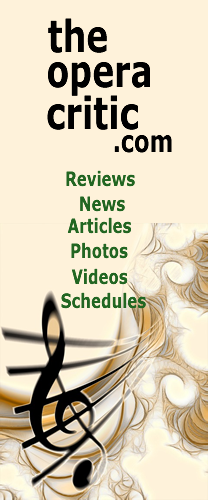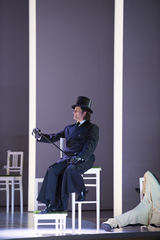| Opera Reviews | 16 April 2024 |
Magnificent music making meets intellectual absurditiesby Moore Parker |
|
| Gounod: Faust Salzburg Festival 10 August 2016 |
|
|
Showing an undoubted affinity with the music (and with the Vienna Philharmonic Orchestra), Pérez wove an intimate and vibrant reading through most of this evening, elevating a score that can easily appear trite and timeworn. Occasional differences between stage and pit were minimal and maybe a reflection of first-night nerves on all sides. In the title role, Piotr Beczala appeared in pristine form, wonderfully fluid in delivery and projecting more than adequate volume to fill the house when required. Perhaps a straight fortissimo high C in “Salut demure” is today’s only option - but the note was as impressive as the phrasing and attention to the words that preceded it. Act 3’s duet between Faust and Marguerite, “Ô nuit d’amour...” was exemplary, and gilded with exquisitely-poised pianissimi in which both tenor and soprano were in rapturous union with the pit. If often tending toward stock operatic pose and gesture, Beczala nevertheless created an elegant and credible stage character - both pre-and-post pact with Méphistophélès. Maria Agresta presented a beautifully-shaped performance with a pleasing balance of youthful purity and grace. Vocally dark in timbre and with a tendency to sacrifice diction for tonal quality, she occasionally echoed the young Katia Ricciarelli in both her assets and deficiencies. While her account of “Du Roi du Thulé” was suitably plaintive, the Jewel Song could have gained from a touch more exuberance and sparkle. But for the high Cs in the finale, Ms. Agresta appeared in possession of the reserves for a part all too easily underestimated. As Méphistophélès Ildar Abdrazakov spins his heinous web with sardonic alacrity and a certain charm, excelling in the music’s lyrical and higher-lying phrases (his evening’s trump card was “Vous qui fates l’endormie”) while, however, generally lacking the ideal profound darkness of timbre and the vocal thrust to generate a sense of deference or foreboding. Nevertheless, a well-cut and polished gem of distinguished quality. Alexey Markov’s Valentin took some time to find form, sounding a shade rough-toned and even indisposed in his Act 2 Cavatina, but rose to the occasion for his admonishment scene and ultimate demise to score high marks with the audience. Marie-Ange Todorovitch left a particularly strong impression with her vocally imposing and characterful Marthe, while Tara Erraught presented a rather light-toned pubescent - if full-bearded - Siébel. Paolo Rumetz nicely complimented the line-up with his rather dapper Wagner. The production team of Birgit and Reinhard von der Thannen (who collaborated with Hans Neuenfels in the controversial rat-ridden Lohengrin at Bayreuth) were responsible for the concept, direction, staging and costumes. Of the protagonists, Méphistophèles was arguably the most-rounded and interesting creation (in part, no doubt thanks to Abdrazakov’s attributes), while the remaining characters came across as pretty standard in definition and handwork. After their pact it transpires that Méphistophèles operates as Faust’s alter ego, appearing in partner-look costume while sourcing the elements required for the the plot’s advances in his mobile Cabin Trunk, boldly labelled “M”. It is here too that Marguerite finds her “jewels” (a sparkling stole which she drapes over her shoulders). Other elements include a white military hospital style bed for Marguerite’s seduction, a giant symbolic daisy, and an enormous human skeleton which is lowered for Act 4’s soldiers’ chorus. Six enormous black balls are rolled by dancers around Marguerite’s crumpled and forlorn figure - now dressed in black after her downfall and carrying a white carton to depict her child’s small coffin. A model house and church tower are pulled across the stage on wheels by Méphistophèles and Faust respectively, as the action draws towards its close. The work’s choral scenes are significant, and the creative team here chose to augment their musical activities with a generous amount of choreographed movement - potentially a potent visual asset if conducted consummately, but embarrassingly chaotic when not. Costumed in banana-coloured pierrot overalls, the Philharmonia Chor Wien seemed not quite d’accord with their task, at times out of sync musically and only truly finding form in Act 4’s male constellation. The printed program (in finest Festival format including full libretto and German-English articles) features a 20-page analysis by philosophy professor Mirjam Schaub, who retraces the background of the opera while detailing the production team’s intellectual - and evidently assiduous - considerations. As an example, this short except describes the omnipresent white rear set with its centred oval eye-shaped cut out: “The overall structure has a sculptural quality that oscillates with great virtuosity between LOW and HIGH: while the eye will remind some of the Odyssean one-eyed Cyclos, others will recall the 1970’s logos of the ORF (Austrian Broadcasting Corporation) or ARD (German Federal Radio Stations); George Orwell’s 1984 or Stanley Kubrick’s 2001 may also quite legitimately spring to mind. And if the eye makes you think of the platinum LP with an aria of the Queen of the Night that was on the space ship “Voyager” on its quest for other forms of intelligence in the infinite depths of the universe - or maybe, carved its way through a soulless nothingness - then you are in good company, because von der Thannen associates it with that too.” So, in essence, carte blanche for the audience - but it may help to buy a program to point you towards the insight of those behind the concept. Regrettably, less attention was apparently given to the curtain calls, and the indecision by the leads as to their comings and goings after the first round of solo bows (there were but two) added a barb to the round of boos which greeted the production team when they finally appeared.
|
|
| Text ©
Moore Parker Photo © Salzburger Festspiele / Monika Rittershaus |

 The onus of success unquestionably lay with the musical aspect of this new production of Gounod’s Faust - boasting a stellar cast under the baton of the Argentinean conductor Aleja Pérez, who returns to Salzburg after his debut here last year conducting Werther in concert.
The onus of success unquestionably lay with the musical aspect of this new production of Gounod’s Faust - boasting a stellar cast under the baton of the Argentinean conductor Aleja Pérez, who returns to Salzburg after his debut here last year conducting Werther in concert.





